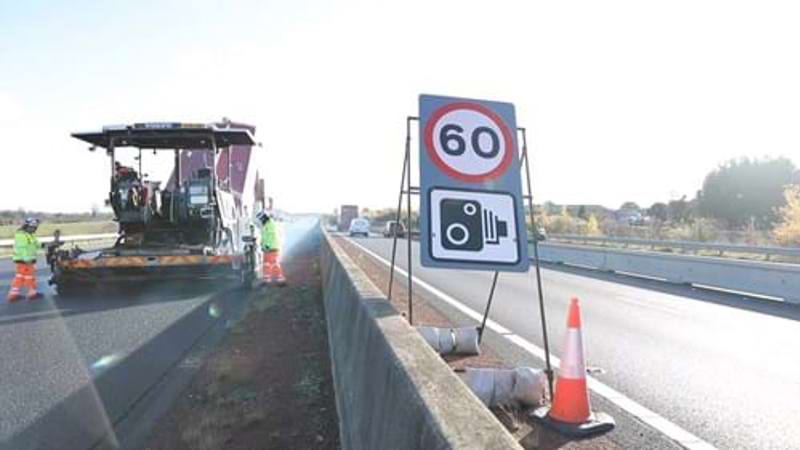Highest safe speed in roadworks
Our vision is to improve customers' experience through roadworks by implementing the highest safe speed while maintaining the safety of our roadworkers and users.

Speed limits help manage risk around roadworks and are often an essential part of the temporary traffic management to ensure the safety of road users. Various factors may determine whether a speed restriction is required, including:
- the work activity
- duration of the work
- safety zones
This then supports design of the temporary traffic management and ultimately the use of any temporary speed limits
Historically roadworks for our major schemes have been designed and operated with a reduced speed limit of 50mph or lower. We understand that roadworks and associated speed limits can be a key source of frustration for our customers. We've worked with our supply chain partners to think innovatively about the way we approach speed limits in roadworks. The DMRB standard GD 904 gives requirements and information about how we expect our schemes to achieve the highest safe speed as part of their works.
Using the best practice adopted from both trials and safety monitoring, We've prepared the Highest Safe Speed Toolkit to assist our projects implement the highest safe speed in roadworks:
- Implementing the highest safe speed in roadworks – Guidance
- Implementing the highest safe speed in roadworks – Hazard assessment guidance
- Implementing the highest safe speed in roadworks – Programme level safety risk assessment
By safely implementing highest safe speed, we'll continue to reduce journey times, boost the economy and give customers a better experience on our strategic road network.
60mph speed limit trials
In 2016 we committed to investigating the potential for higher speed limits in roadworks where they could be safely implemented. Customers tell us they find a blanket approach to speed limits in roadworks inappropriate. Safely improving our customers’ experience is a key part of our customer service strategy.
The first phase of the trials considered both 55mph and 60mph speed limits. The findings showed that safety wasn’t compromised and customers preferred driving at 60mph. Following the trials, Interim Advice Note (IAN) 182 (now known as GG182) was updated, asking schemes to consider their site-specific speed limit during the commissioning phase of their works. The full findings from the trials can be found below.
The second phase of trials, which commenced on road in 2019, have considered whether a 60mph speed limit in roadworks can safely be used in a wider range of roadworks scenarios. These scenarios include:
Permanent – 60mph running over 24/7 period
Contraflow – Design roadworks for 60mph using a contraflow arrangement and run at 60mph on the carriageway where main works activity is not taking place
Dynamic – Design roadworks to 60mph but only use 60mph during non-working days, that is, Sundays/Bank holidays/Christmas shutdown
The work taken from the trials has been taken forward and helped form the toolkit which is available above. Case studies from the phase 2 trials can be found below.
2018-2020 Phase 2 – 60mph speed limit through roadworks (trial reports)
The purpose of the phase 2 trials was to expand 60mph into additional roadworks scenarios (permanent, contraflow and dynamic) where safe to do so. These trials have shown that we can deliver benefits for road users while maintaining safety for roadworkers, and the travelling public.
The following are the final monitoring and evaluation reports for this group of 60mph on-road trials prepared by TRL (Transport Research Laboratory), our technical consultants.
- Report for the on-road trial of 60mph on the M49 Avonmouth scheme
- Report for the on-road trial of 60mph on the M5 Willand scheme
- Report for the on-road trial of 60mph on the M20 Junction 10a scheme
- Report for the on-road trial of 60mph on the M1 Junctions 13 to 16 scheme
- Report for the on-road trial of 60mph on the A1 Leeming to Ripon scheme
- Report for the on-road trial of 60mph on the M6 Junctions 2a to 4 scheme
- Report for the on-road trial of 60mph on the M6 Junctions 13 to 15 scheme
- Report for the on-road trial of 60mph on the M4 Junctions 3 to 12 scheme
The following are customer reports for this group of 60mph on-road trials prepared by our technical consultants, TRL and Ipsos Mori.
2016-2018 Phase 1 – 60mph speed limit through roadworks (trial reports)
The purpose of the phase 1 trials was to demonstrate whether the concepts of 60mph and 55mph in roadworks could be safely implemented.
Reports
The following are the final independent reports prepared by TRL and WSP (Mouchel), our technical consultants.
- Summary of 60mph trials
- Simulator Report 1
- Simulator Report 2
- Monitoring and evaluation M1 junction 32 to 35a
- Monitoring and evaluation A1 Leeming to Barton
- Monitoring and evaluation M5 junction 4A to 6
- Stakeholder Engagement M1 junction 32 to 35a
- Stakeholder Engagement A1 Leeming to Barton
- Stakeholder Engagement M5 junction 4A to 6
- Safety risk assessment
55/60mph narrow lane simulations prepared by TRL
With TRL we carried out simulations to investigate the use of both 55 mph and 60 mph speed limits within road works with narrow lane widths:
55mph through roadworks
The following are individual reports prepared by TRL, WSP (Mouchel) and Highways England:
